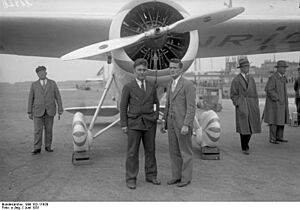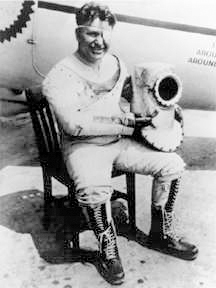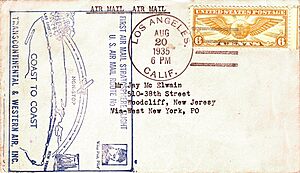Wiley Post facts for kids
Quick facts for kids
Wiley Post
|
|
|---|---|
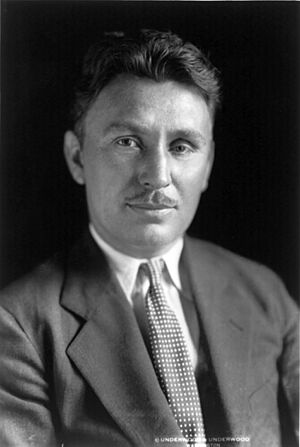 |
|
| Born | November 22, 1898 |
| Died | August 15, 1935 (aged 36) |
| Occupation | Aviator |
| Spouse(s) | Mae Laine (m. June 27, 1927) |
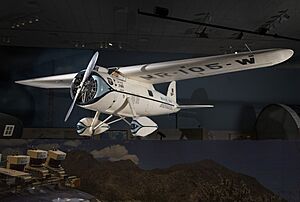
Wiley Hardeman Post (born November 22, 1898 – died August 15, 1935) was a brave American pilot. He lived during the time between the two World Wars. Wiley Post was the first person to fly solo (by himself) all the way around the world!
He was also famous for flying very high up. Post helped create one of the first special suits that allowed pilots to breathe at high altitudes. He also discovered the jet stream, which are fast-moving air currents high in the atmosphere. On August 15, 1935, Wiley Post and his friend, the humorist Will Rogers, died when their plane crashed in Alaska.
Post's famous plane, the Winnie Mae, was a Lockheed Vega. It was shown at the National Air and Space Museum's Steven F. Udvar-Hazy Center for many years. Now, you can see it in the "Time and Navigation" gallery at the main National Air and Space Museum in Washington, D.C.
Contents
Wiley Post's Early Life
Wiley Post was born on a cotton farm in Texas. His father was William Francis, and his mother was Mae Quinlan Post. His mother had some Cherokee heritage. When Wiley was five, his family moved to Oklahoma.
He wasn't the best student, but he did finish sixth grade. By 1920, his family settled on a farm near Maysville, Oklahoma.
How Wiley Post Discovered Flying
In 1913, Wiley saw an airplane for the very first time! It was at a county fair in Lawton, Oklahoma. The plane was a "Pusher type" made by Curtiss-Wright. This event made him so excited that he immediately joined the Sweeney Automobile and Aviation School in Kansas City.
After seven months, he went back to Oklahoma. He started working at the Chickasaw and Lawton Construction Company. During World War I, Post wanted to become a pilot in the U.S. Army Air Service. He learned about radio technology at the University of Oklahoma. However, the war ended before he finished his training. After the war, he worked in the Oklahoma oilfields.
Wiley Post's First Flights
Wiley Post's career in aviation began when he was 26. He started as a parachutist for a flying circus called Burrell Tibbs and His Texas Topnotch Fliers. He became well-known for his daring jumps at airshows.
An Accident and a New Start
On October 1, 1926, Post had a serious accident while working on an oil rig. A piece of metal hit his left eye. The injury caused him to lose sight in that eye forever. After that, he usually wore an eyepatch. He used money he received from the accident settlement to buy his very first airplane.
Around this time, he met Will Rogers, who was also from Oklahoma. Post flew Rogers to a rodeo, and they became good friends. In 1930, Post became the personal pilot for two rich Oklahoma oilmen, Powell Briscoe and F.C. Hall.
Winning the National Air Race Derby
F.C. Hall bought a special plane called a Lockheed Vega. It was a high-wing, single-engine aircraft. This type of plane was famous for breaking records in the early 1930s. The oilman named the plane the Winnie Mae after his daughter.
Wiley Post became famous when he won the National Air Race Derby in the Winnie Mae. He flew from Los Angeles to Chicago. His time was 9 hours, 8 minutes, and 2 seconds. This win earned him a prize of $7,500.
Flying Around the World
In 1930, the record for flying around the world was held by a huge airship called the Graf Zeppelin. It took 21 days. Wiley Post wanted to break this record in an airplane.
On June 23, 1931, Post and an Australian navigator named Harold Gatty started their journey. They took off from Roosevelt Field in New York in the Winnie Mae. Their plan was to fly around the world, stopping in many countries.
They landed in places like Newfoundland, England, Germany, Russia, and Alaska. In Nome, Alaska, they had to fix their propeller. In Fairbanks, Alaska, they replaced it. They finally returned to Roosevelt Field on July 1. They had flown 15,474 miles (24,903 km) in a record time of 8 days, 15 hours, and 51 minutes! This was the first time a single-engine plane successfully flew around the world.
When they returned, people celebrated them like heroes, similar to how Charles Lindbergh was celebrated. They had lunch at the White House and a big parade in New York City. After this amazing flight, Post bought the Winnie Mae from F.C. Hall. He and Gatty wrote a book about their journey called Around the World in Eight Days.
First Solo Flight Around the World
After his record-setting flight, Wiley Post wanted to start his own flying school. But he couldn't get enough money. Some people doubted him because he came from a rural background and didn't have much formal education. This made Post even more determined.
He decided to try flying around the world again, but this time all by himself! He also wanted to break his own speed record. Over the next year, Post made his plane even better. He added an autopilot system and a radio direction finder. These were new technologies being developed by the Sperry Corporation and the United States Army.
In 1933, he flew around the world again, using the autopilot and compass instead of a navigator. He became the first person to fly around the world alone! He left from Floyd Bennett Field and made stops for repairs and to pick up maps. Fifty thousand people cheered for him when he returned on July 22. He completed the flight in 7 days, 18 hours, and 49 minutes.
Developing the Pressure Suit
In 1934, with help from Frank Phillips of the Phillips Petroleum Company, Post started exploring how high and how far planes could fly. The Winnie Mae could not be sealed to keep the air pressure normal inside. So, Post worked with Russell S. Colley to create the world's first useful pressure suit.
Three pressure suits were made for Wiley Post. Only the last one worked well. The first suit broke during a test. The second suit was too tight and had to be cut off Post. The third suit was designed better.
How the Pressure Suit Worked
The suit had three layers: long underwear, a black rubber layer for air pressure, and an outer layer of rubberized parachute fabric. This outer layer was glued to a frame with joints for his arms and legs. This allowed him to move and control the plane. It also had pigskin gloves, rubber boots, and a helmet like a diver's helmet.
The helmet had a faceplate that could be sealed when he flew above 17,000 ft (5,200 m). It also had earphones and a throat microphone. The helmet was cylinder-shaped with a round window. In his first flight using the suit on September 5, 1934, Post flew to 40,000 ft (12,000 m) above Chicago.
Eventually, he flew as high as 50,000 ft (15,000 m)! By doing this, Post discovered the jet stream. He also made the first big steps in flying safely at very high altitudes. As of 2022, you can see this amazing suit on display at the museum.
Trying High-Altitude Flights Across the U.S.
Between February and June 1935, Post tried four times to make the first non-stop, high-altitude flight from Los Angeles to New York. All of these attempts failed because of mechanical problems with the plane.
These flights were meant to be the "First Air Mail Stratosphere Flight." Post carried special mail covers on all four flights. When Post died in August 1935, these covers were cancelled in Los Angeles and sent to their addresses.
Wiley Post's Last Flight
In 1935, Wiley Post became interested in finding a new air route for mail and passengers from the West Coast of the United States to Russia. He didn't have much money, so he built a special plane. He used parts from two different aircraft: the body of a Lockheed Orion and the wings from a crashed Lockheed Explorer.
The Explorer wings were six feet longer than the Orion's original wings. This extra length helped the plane fly farther. The Explorer wings also didn't have landing gear that could be pulled up. This made it easy to add floats so the plane could land on lakes in Alaska and Siberia. The Lockheed company didn't want to make these changes because they thought the two designs were not safe together. So, Wiley made the changes himself.
The Final Journey
Wiley Post's friend Will Rogers often visited him while the plane was being changed. Rogers asked Post to fly him to Alaska. He wanted to find new ideas for his newspaper column. The floats Post ordered were delayed, so he used a set designed for a bigger plane. This made the plane heavier in the front.
After a test flight in July, Post and Rogers left Lake Washington, near Seattle, in early August. They made several stops in Alaska. While Post flew the plane, Rogers wrote his columns. On August 15, they left Fairbanks, Alaska, heading for Point Barrow.
They were only a few miles away when bad weather made them unsure of their exact location. They landed in a lagoon to ask for directions. When they tried to take off again, the engine stopped working at a low height. The plane, which was heavy in the front, crashed into the lagoon. The right wing broke off, and the plane ended up upside down in the shallow water. Both men died instantly.
Wiley Post is buried in Memorial Park Cemetery in Oklahoma City, Oklahoma.
Honors and Tributes to Wiley Post
In 1936, the Smithsonian Institution bought the Winnie Mae from Post's wife for $25,000. Two monuments at the crash site remember the two men. These monuments are listed on the National Register of Historic Places. The nearby Wiley Post–Will Rogers Memorial Airport in Utqiagvik, Alaska is named after them.
Wiley Post Airport, a big airport in Oklahoma City, is named after Post. Oklahoma City's main commercial airport is named after Will Rogers. This way, both men are honored by airports in Oklahoma City. There is also a seaplane base on Lake Washington in Renton, Washington, named the Will Rogers – Wiley Post Memorial Seaplane Base.
The U.S. Army Air Forces (now the United States Air Force) named a street after Post. It was on a former military storage depot. This street, Wiley Post Road, is still there today in Bell, California.
Wiley Post received many awards for his achievements. He got the Distinguished Flying Cross in 1932. He also received the Gold Medal of Belgium in 1934 and the International Harmon Trophy in 1934. In 1969, he was added to the National Aviation Hall of Fame. In 1970, he was honored at the First Flight Society's First Flight Shrine at the Wright Brothers National Memorial.
In 1997, he was added to the International Air & Space Hall of Fame at the San Diego Air & Space Museum. In 1979, the United States Postal Service honored Post with two special airmail stamps. In 2004, Post was added to the Oklahoma Hall of Fame.
For many years, the Wiley Post Commission gave out the annual Wiley Post Spirit Award. This award went to people in aviation who showed the same innovative and pioneering spirit as Wiley Post.
Images for kids


